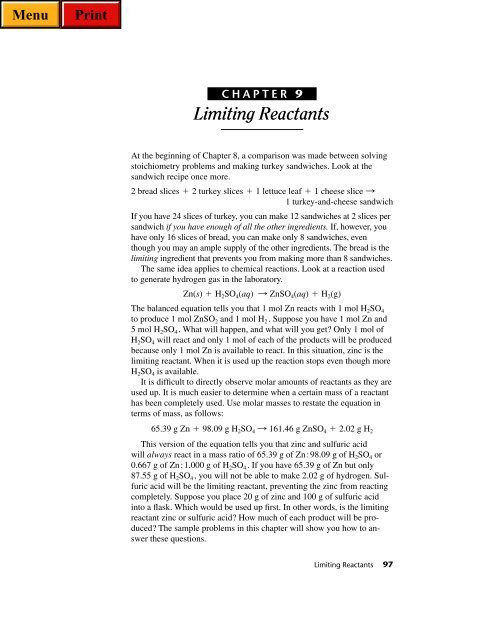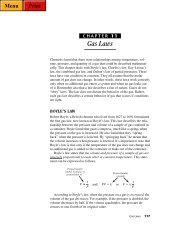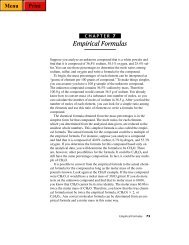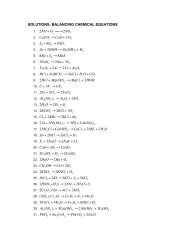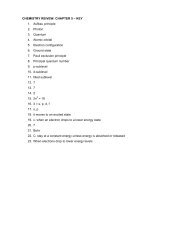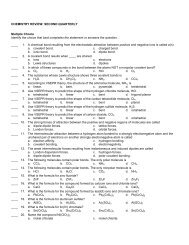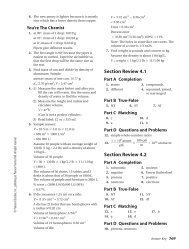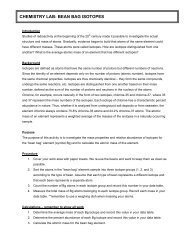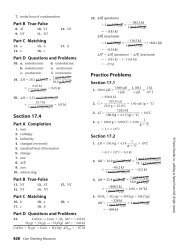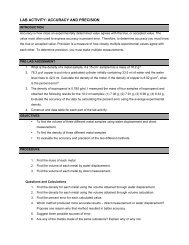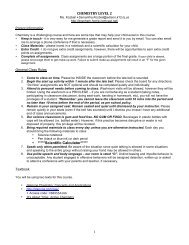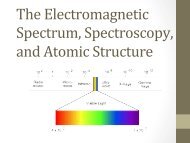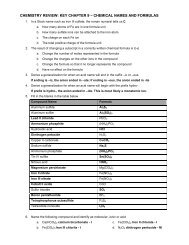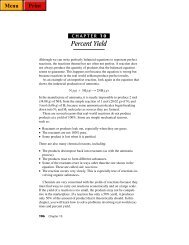You also want an ePaper? Increase the reach of your titles
YUMPU automatically turns print PDFs into web optimized ePapers that Google loves.
CHAPTER 9<br />
<strong>Limiting</strong> Reactants<br />
At the beginning of Chapter 8, a comparison was made between solving<br />
stoichiometry problems and making turkey sandwiches. Look at the<br />
sandwich recipe once more.<br />
2 bread slices 2 turkey slices 1 lettuce leaf 1 cheese slice :<br />
1 turkey-and-cheese sandwich<br />
If you have 24 slices of turkey, you can make 12 sandwiches at 2 slices per<br />
sandwich if you have enough of all the other ingredients. If,however,you<br />
have only 16 slices of bread, you can make only 8 sandwiches, even<br />
though you may an ample supply of the other ingredients. The bread is the<br />
limiting ingredient that prevents you from making more than 8 sandwiches.<br />
The same idea applies to chemical reactions. Look at a reaction used<br />
to generate hydrogen gas in the laboratory.<br />
Zn(s) H2SO4(aq) : ZnSO4(aq) H2(g) The balanced equation tells you that 1 mol Zn reacts with 1 mol H2SO4 to produce 1 mol ZnSO2 and 1 mol H2. Suppose you have 1 mol Zn and<br />
5 mol H2SO4. What will happen, and what will you get? Only 1 mol of<br />
H2SO4 will react and only 1 mol of each of the products will be produced<br />
because only 1 mol Zn is available to react. In this situation, zinc is the<br />
limiting reactant. When it is used up the reaction stops even though more<br />
H2SO4 is available.<br />
It is difficult to directly observe molar amounts of reactants as they are<br />
used up. It is much easier to determine when a certain mass of a reactant<br />
has been completely used. Use molar masses to restate the equation in<br />
terms of mass, as follows:<br />
65.39 g Zn 98.09 g H2SO4 : 161.46 g ZnSO4 2.02 g H2 This version of the equation tells you that zinc and sulfuric acid<br />
will always react in a mass ratio of 65.39 g of Zn:98.09 g of H 2SO 4 or<br />
0.667 g of Zn:1.000 g of H 2SO 4. If you have 65.39 g of Zn but only<br />
87.55 g of H 2SO 4, you will not be able to make 2.02 g of hydrogen. Sulfuric<br />
acid will be the limiting reactant, preventing the zinc from reacting<br />
completely. Suppose you place 20 g of zinc and 100 g of sulfuric acid<br />
into a flask. Which would be used up first. In other words, is the limiting<br />
reactant zinc or sulfuric acid? How much of each product will be produced?<br />
The sample problems in this chapter will show you how to answer<br />
these questions.<br />
<strong>Limiting</strong> Reactants 97
General Plan for Solving <strong>Limiting</strong> Reactant Problems<br />
1A<br />
Mass of<br />
reactant A<br />
available<br />
2A<br />
98 Chapter 9<br />
Convert<br />
using the<br />
molar mass<br />
of A.<br />
Amount of<br />
reactant A<br />
in mol<br />
available<br />
3<br />
Amount of<br />
reactant B<br />
needed to<br />
react with A<br />
6<br />
Mass of<br />
product<br />
Convert<br />
using the mole<br />
B<br />
ratio, .<br />
A<br />
If there are more moles of B<br />
available than needed,<br />
A is the limiting reactant.<br />
If there are fewer moles of B<br />
than needed, B is the<br />
limiting reactant.<br />
Convert<br />
using the<br />
molar mass<br />
of B.<br />
Convert using the<br />
mole ratio,<br />
limiting reactant .<br />
product<br />
1B<br />
Mass of<br />
reactant B<br />
available<br />
2B<br />
4<br />
Amount of<br />
reactant B<br />
in mol<br />
available<br />
<strong>Limiting</strong><br />
Reactant<br />
Convert using the molar<br />
mass of the product. 5<br />
Amount of<br />
product in mol
SAMPLE PROBLEM 1<br />
Calcium hydroxide, used to neutralize acid spills, reacts with<br />
hydrochloric acid according to the following equation:<br />
Ca(OH) 2 2HCl B CaCl 2 2H 2O<br />
If you have spilled 6.3 mol of HCl and put 2.8 mol of Ca(OH) 2<br />
on it, which substance is the limiting reactant?<br />
SOLUTION<br />
1. ANALYZE<br />
• What is given in the the balanced equation, the amounts<br />
problem? of Ca(OH) 2 and HCl in moles<br />
• What are you asked to find? the limiting reactant<br />
Items Data<br />
Reactant Ca(OH) 2 HCl<br />
Coefficient in balanced equation 1 2<br />
Molar mass NA* NA<br />
Amount of reactant 2.8 mol 6.3 mol<br />
Mass of reactant NA NA<br />
<strong>Limiting</strong> reactant ? ?<br />
* not applicable to the problem<br />
2. PLAN<br />
• What steps are needed to Choose one of the reactants. Use the<br />
determine the limiting mole ratio between the two reactants<br />
reactant? to compute the amount of the other<br />
reactant that would be needed to react<br />
with it. Compare that amount<br />
with the amount available.<br />
Amount of Ca(OH) 2<br />
in mol<br />
multiply by<br />
mole ratio<br />
HCl<br />
Ca(OH) 2<br />
2A 2B<br />
3<br />
Amount of HCl needed to<br />
react with Ca(OH) 2<br />
compare moles of HCl<br />
needed with moles of HCl<br />
available<br />
Amount of HCl<br />
in mol<br />
4<br />
<strong>Limiting</strong> reactant<br />
<strong>Limiting</strong> Reactants 99
Choose one of the reactants, for instance, Ca(OH) 2<br />
3. COMPUTE<br />
The computation shows that more HCl (6.3 mol) is available than is<br />
needed (5.6 mol) to react with the 2.8 mol Ca(OH) 2 available. Therefore,<br />
HCl is present in excess, making Ca(OH) 2 the limiting reactant.<br />
4. EVALUATE<br />
• Is the answer reasonable? Yes; you can see that 6.3 mol HCl is<br />
more than is needed to react with<br />
2.8 mol Ca(OH) 2.<br />
PRACTICE<br />
given<br />
mol Ca(OH) 2<br />
1. Aluminum oxidizes according to the following equation:<br />
4Al 3O2 : 2Al2O3 Powdered Al (0.048 mol) is placed into a container<br />
containing 0.030 mol O2. What is the limiting reactant? ans: O2 SAMPLE PROBLEM 2<br />
<br />
2.8 mol Ca(OH) 2 <br />
mole ratio<br />
2 mol HCl<br />
1 mol Ca(OH) 2<br />
2 mol HCl<br />
1 mol Ca(OH) 2<br />
mol HCl needed<br />
5.6 mol HCl needed<br />
Chlorine can replace bromine in bromide compounds forming<br />
a chloride compound and elemental bromine. The following<br />
equation is an example of this reaction.<br />
2KBr(aq) Cl 2(aq) B 2KCl(aq) Br 2(l)<br />
When 0.855 g of Cl 2 and 3.205 g of KBr are mixed in solution,<br />
which is the limiting reactant? How many grams of Br 2 are<br />
formed?<br />
SOLUTION<br />
1. ANALYZE<br />
• What is given in the the balanced equation, and the<br />
problem? masses of Cl2 and KBr available<br />
• What are you asked to find? which reactant is limiting, and the<br />
mass of Br2 produced<br />
100 Chapter 9
Items Data<br />
Substance KBr Cl2 Br2 Coefficient in 2 1 1<br />
balanced equation<br />
Molar mass* 119.00 g/mol 70.90 g/mol 159.80 g/mol<br />
Amount of<br />
substance<br />
? mol ? mol ? mol<br />
Mass of substance 3.205 g 0.855 g ? g<br />
<strong>Limiting</strong> reactant ? ? NA<br />
* determined from the periodic table<br />
2. PLAN<br />
• What steps are needed to Convert mass of each reactant to<br />
determine the limiting amount in moles. Choose one of the<br />
reactant? reactants. Compute the amount of<br />
the other reactant needed. Compare<br />
that with the amount available.<br />
• What steps are needed to Use amount of the limiting reactant<br />
determine the mass of Br 2<br />
and the mole ratio given in the equa-<br />
produced in the reaction? tion to determine the amount of Br 2.<br />
Convert the amount of Br 2 to the<br />
mass of Br 2 using the molar mass.<br />
1a 1b<br />
Mass of KBr in g<br />
multiply by the inverse<br />
molar mass of KBr<br />
2a<br />
Amount of KBr in mol<br />
multiply by mole ratio:<br />
Cl2 KBr<br />
3<br />
Amount of Cl2 needed<br />
to react with KBr<br />
6<br />
Mass of Br2 in g<br />
compare moles of reactant<br />
needed with moles of<br />
reactant available<br />
multiply by the molar mass of<br />
Br 2<br />
Mass of Cl2 in g<br />
multiply by the inverse<br />
molar mass of Cl2 multiply moles of limiting reactant<br />
Br2 by mole ratio:<br />
limiting reactant<br />
2b<br />
Amount of Cl2 in mol<br />
4<br />
<strong>Limiting</strong> reactant<br />
5<br />
Amount of Br2 in mol<br />
<strong>Limiting</strong> Reactants 101
given 1 mol Cl2 g Cl2 mol Cl2 70.90 g Cl2 Choose one of the reactants, KBr for instance.<br />
102 Chapter 9<br />
1<br />
molar mass KBr<br />
given 1 mol KBr<br />
g KBr mol KBr<br />
119.00 g KBr<br />
1<br />
molar mass Cl2 mole ratio<br />
1 mol Cl2 mol KBr mol Cl2 needed<br />
1 mol KBr<br />
calculated above<br />
Determine the limiting reactant.<br />
mole ratio<br />
molar mass Br 2<br />
calculated above<br />
mol Br2 159.80 g Br2 mol limiting reactant <br />
g Br2 mol limiting reactant 1 mol Br2 3. COMPUTE<br />
3.205 g KBr <br />
Choose one of the reactants, KBr, for instance.<br />
Only 0.0121 mol Cl 2 is available. For all of the KBr to react, 0.0136<br />
mol Cl 2 is needed. Therefore, Cl 2 is the limiting reactant.<br />
4. EVALUATE<br />
• Is the determination of Yes; the mass of 2 mol KBr is<br />
limiting reactant 238 g and the mass of 1 mol Cl2 is<br />
reasonable? about 71 g, so they react in roughly<br />
a 3:1 ratio by mass. 3.2 g KBr<br />
would require about 1 g of Cl2,but only 0.855 g is available.<br />
• Are the units and significant The number of significant figures is<br />
figures of the mass of Br 2<br />
1 mol KBr<br />
119.00 g KBr<br />
0.855 g Cl 2 1 mol Cl 2<br />
70.90 g Cl 2<br />
0.0121 mol Cl 2 1mol Br 2<br />
1 mol Cl 2<br />
0.02693 mol KBr<br />
0.0121 mol Cl 2<br />
0.02693 mol KBr 1 mol Cl 2<br />
2 mol KBr 0.01346 mol Cl 2 needed<br />
159.80 g Br 2<br />
1 mol Br 2<br />
1.93 g Br 2<br />
correct because the mass of Cl 2 was<br />
correct? given to three significant figures.<br />
Units cancel to give grams of Br 2.
PRACTICE<br />
1. A process by which zirconium metal can be produced from the mineral<br />
zirconium(IV) orthosilicate, ZrSiO4, starts by reacting it with<br />
chlorine gas to form zirconium(IV) chloride.<br />
ZrSiO4 2Cl2 : ZrCl4 SiO2 O2 What mass of ZrCl4 can be produced if<br />
862 g of ZrSiO4 and 950. g of Cl2 are<br />
available? You must first determine the ans: ZrSiO4 limiting reactant. 1.10 103 g ZrCl4 ADDITIONAL PROBLEMS<br />
1. Heating zinc sulfide in the presence of oxygen yields the following:<br />
ZnS O2 : ZnO SO2 If 1.72 mol of ZnS is heated in the presence of 3.04 mol of O2, which reactant will be used up? Balance the equation first.<br />
2. Use the following equation for the oxidation of aluminum in the following<br />
problems.<br />
4Al 3O2 : 2Al2O3 a. Which reactant is limiting if 0.32 mol Al and 0.26 mol O2 are<br />
available?<br />
b. How many moles of Al2O3 are formed from the reaction of<br />
6.38 103 mol of O2 and 9.15 103 mol of Al?<br />
c. If 3.17 g of Al and 2.55 g of O2 are available, which reactant is<br />
limiting?<br />
3. In the production of copper from ore containing copper(II) sulfide,<br />
the ore is first roasted to change it to the oxide according to the following<br />
equation:<br />
2CuS 3O2 : 2CuO 2SO2 a. If 100 g of CuS and 56 g of O2 are available, which reactant is<br />
limiting?<br />
b. What mass of CuO can be formed from the reaction of 18.7 g of<br />
CuS and 12.0 g of O2? 4. A reaction such as the one shown here is often used to demonstrate<br />
a single replacement reaction.<br />
3CuSO4(aq) 2Fe(s) : 3Cu(s) Fe2(SO4) 3(aq)<br />
If you place 0.092 mol of iron filings in a solution containing<br />
0.158 mol of CuSO4, what is the limiting reactant? How many<br />
moles of Cu will be formed?<br />
<strong>Limiting</strong> Reactants 103
5. In the reaction BaCO3 2HNO3 : Ba(NO3) 2 CO2 H2O, what mass of Ba(NO3) 2 can be formed by combining 55 g BaCO3 and 26 g HNO3? 6. Bromine replaces iodine in magnesium iodide by the following<br />
process:<br />
MgI2 Br2 : MgBr2 I2 a. Which is the excess reactant when 560 g of MgI2 and 360 g of<br />
Br2 react, and what mass remains?<br />
b. What mass of I2 is formed in the same process?<br />
7. Nickel replaces silver from silver nitrate in solution according to the<br />
following equation:<br />
2AgNO3 Ni : 2Ag Ni(NO3) 2<br />
a. If you have 22.9 g of Ni and 112 g of AgNO3, which reactant is<br />
in excess?<br />
b. What mass of nickel(II) nitrate would be produced given the<br />
quantities above?<br />
8. Carbon disulfide, CS2, is an important industrial substance. Its fumes<br />
can burn explosively in air to form sulfur dioxide and carbon dioxide.<br />
CS2(g) O2(g) : SO2(g) CO2(g) If 1.60 mol of CS2 burns with 5.60 mol of O2, how many moles of<br />
the excess reactant will still be present when the reaction is over?<br />
9. Although poisonous, mercury compounds were once used to kill<br />
bacteria in wounds and on the skin. One was called “ammoniated<br />
mercury” and is made from mercury(II) chloride according to the<br />
following equation:<br />
HgCl2(aq) 2NH3(aq) : Hg(NH2)Cl(s) NH4Cl(aq) a. What mass of Hg(NH2)Cl could be produced from 0.91 g of<br />
HgCl2 assuming plenty of ammonia is available?<br />
b. What mass of Hg(NH2)Cl could be produced from 0.91 g of<br />
HgCl2 and 0.15 g of NH3 in solution?<br />
10. Aluminum chips are sometimes added to sodium hydroxide-based<br />
drain cleaners because they react to generate hydrogen gas which<br />
bubbles and helps loosen material in the drain. The equation follows.<br />
Al(s) NaOH(aq) H2O(l) : NaAlO2(aq) H2(g) a. Balance the equation.<br />
b. How many moles of H2 can be generated from 0.57 mol Al and<br />
0.37 mol NaOH in excess water?<br />
c. Which reactant should be limiting in order for the mixture to be<br />
most effective as a drain cleaner? Explain your choice.<br />
104 Chapter 9
11. Copper is changed to copper(II) ions by nitric acid according to the<br />
following equation:<br />
4HNO3 Cu : Cu(NO3) 2 2NO2 2H2O a. How many moles each of HNO3 and Cu must react in order to<br />
produce 0.0845 mol of NO2? b. If 5.94 g of Cu and 23.23 g of HNO3 are combined, which reactant<br />
is in excess?<br />
12. One industrial process for producing nitric acid begins with the following<br />
reaction:<br />
4NH3 5O2 : 4NO 6H2O a. If 2.90 mol NH3 and 3.75 mol O2 are available, how many moles<br />
of each product are formed?<br />
b. Which reactant is limiting if 4.20 104 g of NH3 and<br />
1.31 105 g of O2 are available?<br />
c. What mass of NO is formed in the reaction of 869 kg of NH3 and 2480 kg O2? 13. Acetaldehyde CH3CHO is manufactured by the reaction of ethanol<br />
with copper(II) oxide according to the following equation:<br />
CH3CH2OH CuO : CH3CHO H2O Cu<br />
What mass of acetaldehyde can be produced by the reaction between<br />
620 g of ethanol and 1020 g of CuO? What mass of which reactant<br />
will be left over?<br />
14. Hydrogen bromide can be produced by a reaction among bromine,<br />
sulfur dioxide, and water as follows.<br />
SO2 Br2 H2O : 2HBr H2SO4 If 250 g of SO2 and 650 g of Br2 react in the presence of excess water,<br />
What mass of HBr will be formed?<br />
15. Sulfur dioxide can be produced in the laboratory by the reaction of<br />
hydrochloric acid and a sulfite salt such as sodium sulfite.<br />
Na2SO3 2HCl : 2NaCl SO2 H2O What mass of SO2 can be made from 25.0 g of Na2SO3 and 22.0 g<br />
of HCl?<br />
16. The rare-earth metal terbium is produced from terbium(III) fluoride<br />
and calcium metal by the following single replacement reaction:<br />
2TbF3 3Ca : 3CaF2 2Tb<br />
a. Given 27.5 g of TbF3 and 6.96 g of Ca, how many grams of terbium<br />
could be produced?<br />
b. How many grams of the excess reactant is left over?<br />
<strong>Limiting</strong> Reactants 105
c. MgS 2O 3 , magnesium thiosulfate<br />
d. K 2SnO 3 , potassium stannate<br />
4. a. As 2S 3<br />
b. Re 2O 7<br />
c. N 2H 4O 3 or NH 4NO 3<br />
d. Fe 2Cr 3O 12 or Fe 2(CrO 4) 3<br />
e. C 5H 9N 3<br />
f. C 6H 5F 2N or C 6H 3F 2NH 2<br />
5. a. C 6H 12S 3<br />
b. C 8H 16O 4<br />
c. C 4H 6O 4<br />
d. C 12H 12O 6<br />
6. a. C 4H 4O 4<br />
b. C 4H 8O 2<br />
c. C 9H 12O 3<br />
7. K 2S 2O 5 , potassium metabisulfite<br />
8. Pb 3O 4<br />
9. Cr 2S 3O 12 or Cr 2(SO 4) 3 ,<br />
chromium(III) sulfate<br />
10. C 9H 6O 4<br />
11. C 5H 9N 3 , the empirical formula and<br />
the molecular formula are the same<br />
12. The molecular formulas of the compounds<br />
are different multiples of the<br />
same empirical formula. (FYI: The<br />
first could be acetic acid, C 2H 4O 2 ,<br />
and the second could be glucose,<br />
C 6H 12O 6 , or some other simple<br />
sugar.)<br />
8 Stoichiometry<br />
1. 15 mol (NH 4) 2 SO 4<br />
2. a. 51 g Al<br />
b. 101 g Fe<br />
c. 1.83 mol Fe 2O 3<br />
3. 0.303 g H 2<br />
4. H 2SO 4 2KOH : K 2SO 4 <br />
2H 2O; 1.11 g H 2SO 4<br />
5. a. H 3PO 4 2NH 3 : (NH 4) 2HPO 4<br />
b. 0.293 mol (NH 4) 2HPO 4<br />
c. 970 kg NH 3<br />
6. a. 90.0 mol ZnCO 3; 60.0 mol<br />
C 6H 8O 7<br />
b. 13.5 kg H 2O ; 33.0 kg CO 2<br />
7. a. 60.9 g methyl butanoate<br />
b. 3261 g H 2O<br />
8. a. 0.450 mol N 2<br />
b. 294 g NH 4NO 3<br />
9. Pb(NO 3) 2 2KI : PbI 2 <br />
2KNO 3; 0.751 mg KNO 3<br />
10. 3.3 mol PbSO 4<br />
11. 2LiOH CO 2 : H 2O Li 2CO 3;<br />
360 g H 2O<br />
290 ChemFile Mini-Guide to Problem Solving<br />
12. a. 38.1 g H 2O<br />
b. 40.1 g H 3PO 4<br />
c. 0.392 mol H 2O<br />
13. C 2H 5OH 3O 2 : 2CO 2 3H 2O;<br />
81.0 g C 2H 5OH<br />
14. 76.5 g H 2SO 4; 12.5 g O 2<br />
15. 2NaHCO 3 : Na 2CO 3 H 2O <br />
CO 2 ; 1.31 g CO 2<br />
16. a. 2N 2H 4 N 2O 4 : 3N 2 4H 2O<br />
b. 1 mol N 2O 4 to 3 mol N 2<br />
c. 30 000 mol N 2<br />
d. 3.52 10 5 g H 2O<br />
17. 2HgO(s) : 2Hg(l) O 2(g);<br />
1.1954 mol O 2<br />
18. 2Fe 3 Cl 2 : 2FeCl 3;<br />
30.5 g Fe<br />
19. 9.26 mg CdS<br />
20. a. 1.59 mol CO 2<br />
b. 0.0723 mol C 3H 5(OH) 3<br />
c. 535 g Mn 2O 3<br />
d. 8.33 g C 3H 5(OH) 3; 4.97 g CO 2<br />
21. a. 3.29 10 3 kg of HCl<br />
b. 330 g CO 2 (s)<br />
22. a. 6.53 10 5 g NH 4ClO 4<br />
b. 160 kg NO(g)<br />
23. a. 1.70 10 6 mol H 3PO 4<br />
b. 666 kg of CaSO 4 2H 2O<br />
c. 34 metric tons of H 3PO 4<br />
24. 1670 kg<br />
9 <strong>Limiting</strong> Reactants<br />
1. 2ZnS 3O 2 : 2ZnO 2SO 2; Zn<br />
is limiting<br />
2. a. Al is limiting<br />
b. 4.25 10 3 mol Al 2O 3<br />
c. O 2 is limiting<br />
3. a. CuS is limiting<br />
b. 15.6 g CuO<br />
4. Fe is limiting; 0.158 mol Cu<br />
5. 54 g Ba(NO 3) 2<br />
6. a. 38 g Br 2<br />
b. 510 g I 2<br />
7. a. Ni is in excess<br />
b. 60.2 g Ni(NO 3) 2<br />
8. CS 2(g) 3O 2(g) : 2SO 4(g) <br />
CO 2(g)<br />
0.80 mol O 2 remain<br />
9. a. 0.84 g Hg(NH 2)Cl<br />
b. 0.84 g<br />
10. a. 2Al(s) 2NaOH(aq) <br />
2H 2O(l) : 2NaAlO 2(aq) <br />
3H 2(g)<br />
b. NaOH is limiting; 0.56 mol H 2
c. Al should be limiting because<br />
you would not want aluminum<br />
metal remaining in the drain.<br />
11. a. 0.0422 mol Cu; 0.169 mol HNO 3<br />
b. Cu is in excess<br />
c. 3.32 g H 2O<br />
12. a. 2.90 mol NO;<br />
4.35 mol H 2O<br />
b. NH 3 is limiting<br />
c. NH 3 is limiting; 1.53 10 3 kg<br />
NO<br />
13. 565 g CH 3CHO;<br />
29 g CH 3CH 2OH remains<br />
14. 630 g HBr<br />
15. 11.3 g SO 2<br />
16. a. 18.4 g Tb<br />
b. 2.4 g TbF 3<br />
10 Percentage Yield<br />
1. a. 64.3% yield<br />
b. 58.0% yield<br />
c. 69.5% yield<br />
d. CH 3CH 2OH is limiting; 79%<br />
yield<br />
2. a. 69.5% yield<br />
b. 79.0% yield<br />
c. 48% yield<br />
d. 85% yield<br />
3. a. 59% yield<br />
b. 81.0% yield<br />
c. 2.3 10 5 mol P<br />
4. a. 91.8% yield<br />
b. 0.0148 mol W<br />
c. 16.1 g WO 3<br />
5. a. 86.8% yield<br />
b. 92.2% yield<br />
c. 2.97 10 4 kg CS 2;<br />
4.39 10 4 kg S 2Cl 2<br />
6. a. 81% yield<br />
b. 2.0 10 2 g N 2O 5<br />
7. 80.1% yield<br />
8. a. 95% yield<br />
b. 9.10 10 2 g Au<br />
c. 9 10 4 kg ore<br />
9. a. 87.5% yield<br />
b. 0.25 g CO<br />
10. a. 71% yield<br />
b. 26 metric tons<br />
c. 47.8 g NaCl<br />
d. 500 kg per hour NaOH<br />
11. a. 2Mg O 2 : 2MgO<br />
b. 87.7% yield<br />
c. 3Mg N 2 : Mg 3N 2<br />
d. 56% yield<br />
12. a. 80.% yield<br />
b. 66.2% yield<br />
c. 57.1% yield<br />
13. 2C 3H 6(g) 2NH 3(g) 3O 2(g) :<br />
2C 3H 3N(g) 6H 2O(g)<br />
91.0% yield<br />
14. a. CO 2H 2 : CH 3OH<br />
3.41 10 3 kg<br />
b. 91.5% yield<br />
15. 96.9% yield<br />
16. 6CO 2 6H 2O : C 6H 12O 6 6O 2<br />
6.32 10 3 g O 2<br />
17. 27.6 kg CaO<br />
11 Gas Laws<br />
1. a. 105 kPa<br />
b. 5.0 mL<br />
c. 42.4 kPa<br />
d. 6.78 10 3 dm 3<br />
e. 1.24 atm<br />
f. 1.5 m 3<br />
2. 8.0 m 3<br />
3. 0.0258 atm<br />
4. 8.01 10 2 dm 3<br />
5. a. 234 K<br />
b. 1.2 dm 3<br />
c. 269.17°C<br />
d. 8.10 10 2 L<br />
e. 487 cm 3<br />
f. 67.9 m 3<br />
6. 1.45 cm 3<br />
7. 40.°C<br />
8. a. 208.6°C<br />
b. 5.5 kPa<br />
c. 2.61 atm<br />
d. 297°C<br />
e. 35.6 atm<br />
f. 39 K<br />
9. 0.899 atm<br />
10. 2.23 atm<br />
11. 7.98 K<br />
12. a. 2.02 L<br />
b. 75.8 kPa<br />
c. 110 K<br />
d. 4.69 10 3 mm 3<br />
e. 72°C<br />
f. 2.25 atm<br />
13. 379 cm 3<br />
14. 98 kPa<br />
15. 1.00 atm; use Boyle’s law to find the<br />
pressure of each gas in the whole<br />
Answer Key 291


